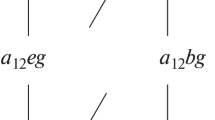Abstract
A general framework for representing incomplete domain knowledge through the use of predicate variables is given. Explanation-based learning (EBL) and similarity-based learning (SBL) are reinterpreted in terms of Horn-clause resolution. It is shown that, thus reinterpreted, EBL and SBL can be naturally integrated to produce an “abductive” method for refining incomplete domain knowledge.
Similar content being viewed by others
References
F. Bergadano, A. Giordana and L. Saitta, Concept acquisition in an integrated EBL and SBL environment,Proc. ECAI-88 (1988) pp. 363–368.
W. Buntine, Generalized subsumption and its applications to induction and redundancy, Art. Int. 36 (1988) 149–176.
A.P. Danyluk, Finding new rules for incomplete theories,Proc. 6th ICML, Ithaca, NY (1989) pp. 34–36.
G.F. Dejong and R.J. Mooney, Explanation-based learning: An alternative view, Machine Learning 1 (1986) 145–176.
T. Dietterich and R. Michalski, A comparative review of selected methods for learning from examples, in:Machine Learning: An AI Approach, eds. R. Michalski, J. Carbonell and T. Mitchell (Tioga Publ., Palo Alto, CA, 1983) pp. 41–82.
R. Hall, Learning by failing to explain, Machine Learning 3 (1988) 45–77.
F. Hayes-Roth and J. McDermott, An interference-matching technique for inducing abstractions, Comm. ACM 21 (1978) 401–410.
F. van Harmelen and A. Bundy, Explanation-based generalization=partial evaluation, Art. Int. 36 (1988) 401–412.
S. Kedar-Cabelli, and L.T. McCarthy, EBG as resolution theorem proving,Proc. 4th Int. Machine Learning Workshop, Irvine, CA (1987) pp. 383–389.
M. Lebowitz, Integrated learning: Controlling explanation, Cognitive Sci. 10 (1986) 219–240.
T.M. Mitchell, R. Keller and S. Kedar-Cabelli, Explanation-based generalization: A unifying view, Machine Learning 1 (1986) 47–80.
R.J. Mooney and D. Ourston, Induction over the unexplained,Proc. 6th ICML, Ithaca, NY (1989) pp. 5–7.
D. Ourston and R.J. Mooney, Changing the rules: A comprehensive approach to theory refinement,Proc. AAAI-90 (1990) pp. 815–820.
M.J. Pazzani, Detecting and correcting errors of omission after explanation-based learning,Proc. 11th IJCAI, Detroit, MI (1989) pp. 713–718.
G.D. Plotkin, A note on inductive generalization, in:Machine Intelligence 5, eds. B. Meltzer and D. Michie (Elsevier, 1970).
G.D. Plotkin, A further note on inductive generalization, in:Machine Intelligence 6, eds. B. Meltzer and D. Michie (Elsevier, 1971).
Y. Sagiv, Optimizing datalog programs,Proc. Foundations of Deductive Databases and Logic Programming Workshop, Washington, DC (1986) pp. 136–162.
S. Vere, Induction of concepts in the predicate calculus,Proc. 4th IJCAI, Tbilisi, USSR (1975) pp. 281–287.
P.H. Winston, Learning structure descriptions from examples, in:The Psychology of Computer Vision, ed. P.H. Winston (McGraw-Hill, 1975).
Author information
Authors and Affiliations
Rights and permissions
About this article
Cite this article
Koppel, M. ESBL: An integrated method for learning from partial information. Ann Math Artif Intell 4, 323–343 (1991). https://doi.org/10.1007/BF01531063
Issue Date:
DOI: https://doi.org/10.1007/BF01531063




